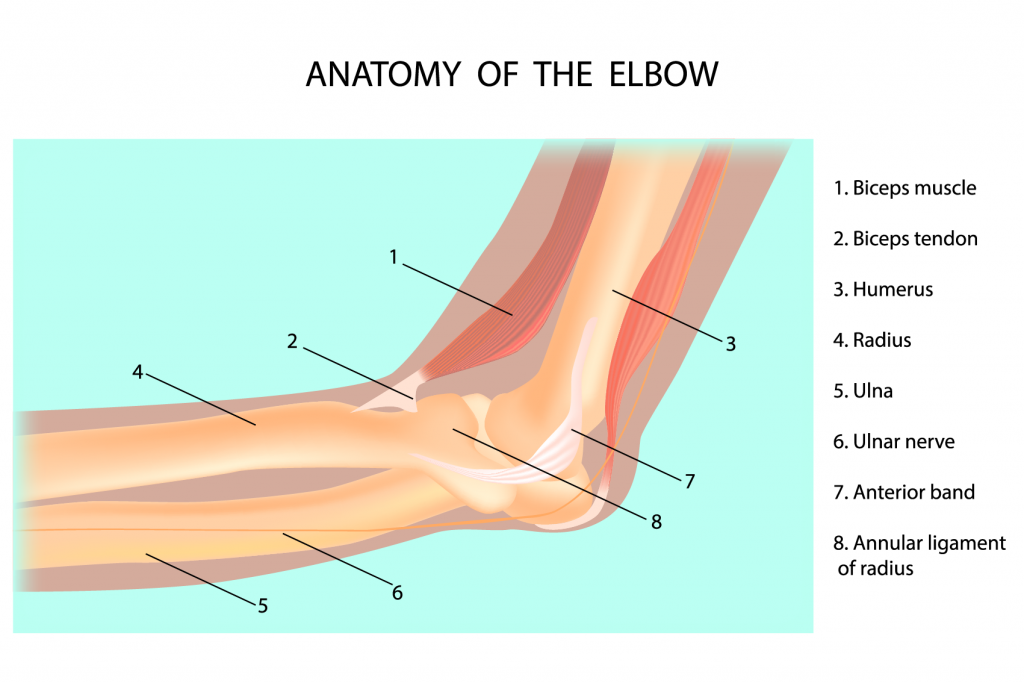Attachment pain in the knee, hip, elbow, back, groin, head, ribs, neck, lower back or shoulder?
Enthesitis is a rheumatic inflammatory disease at the site where one or more tendons are attached to the bone. This condition is also called attachment pain (enthesopathy or enthesiopathy). The main complaints are: pain and stiffness. This inflammatory reaction occurs mainly in the shoulder, elbow, hip, back, groin, neck and knee, but may also occur in other parts of the body. In most cases this disease is temporary.

A tendon is an extension of a muscle. Tendons connect the muscles to the bones. Click to enlarge this example of the elbow.
What is the cause of enthesitis?
Tendons are actually an extension of the muscles. They are sturdy and elastic strings that connect the muscles to the bones. This allows the joints to move. This point of attachment is called enthesis. An inflammatory reaction at this site may occur if you are overloaded by a joint. For example by heavy lifting, intensively repeating specific movements or prolonged effort during exercise. A tennis arm is perhaps the best known example of this condition. The inflammatory reaction may then occur by tightening the muscles of the forearm while reversing the wrist. Also, enthesitis may be a side effect of another rheumatic disorder.
What are the symptoms of enthesitis?
This condition causes a painful and stiff feeling around the affected joints. In addition, there may be a swelling and a warm feeling at the site of inflammation. The pain can radiate. Sometimes it is difficult to move the affected joint. Perhaps the tendon sheath is also inflamed. You’ll hear a cracking noise when moving the tendons. This can be painful.
What is the difference between bursitis, tendinitis and enthesitis?
The symptoms of these three conditions are very similar. In addition, the same joints are often affected, such as shoulder, elbow and knee. Therefore, it is important to explain the differences between these three types of joint disorder. In tendinitis is not the tendon attachment, but the tendon itself inflamed (read more about a tendon inflammation in the shoulder). This complaint can also be accompanied by an inflammation of the tendon sheath. Then this condition is called tendovaginitis. In bursitis, the mucus fair is inflamed. This is a type of pad that is found in places where muscles and joints intersect.
How is enthesitis diagnosed?
The doctor will first thoroughly investigate how and when the complaints are exactly originate. This allows him to determine whether or not overload of the joints plays a role. He will also inform you if you have another rheumatic condition. Then a comprehensive physical examination follows. A laboratory examination or X-ray may also be one of the possibilities.
How is an enthesitis treated?
With the correct treatment, the complaints will usually disappear after a while. First, the doctor will see if a simple painkiller like Paracetamol makes the pain more bearable. If the symptoms persist, your doctor will prescribe an anti-inflammatory analgesic. ‘Moving without pain’ continues to warn against the annoying side effects of NSAIDs. Liquid Green-lipped mussel with Bio-Curcumin and Blackcurrant leaf is a good alternative to inflammation in and around the joints in our opinion. This joint formula contains natural ingredients that inhibit inflammation at different levels. Within about three months of using this liquid compound there should be a clear relief of the complaints.

Share this page
Tweet

Download for free the booklet ‘Moving without pain’ with a retail value of $6.75 / £4.95.
Any questions? Please feel free to contact us. Contact us.





